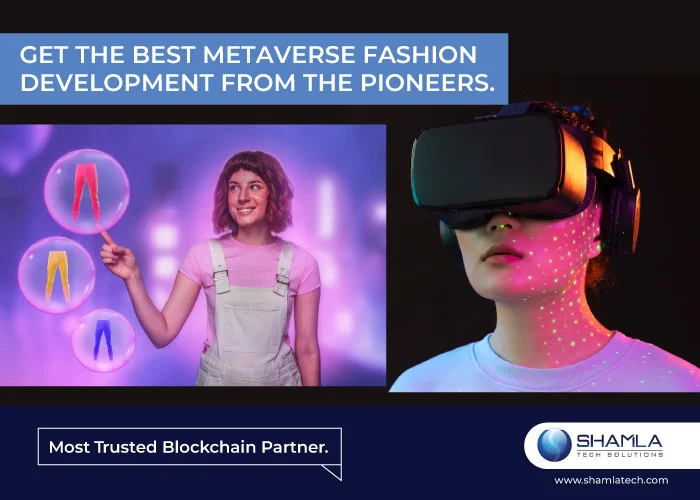Fashion is largely thought of as real-world entity, with tangible clothing items and runway shows with the season’s latest trends that can be sold, bought, and held in a consumer’s hands. But how will be the future of fashion? As the latest technology, metaverse continues to expand, so does the world of virtual fashion brands with metaverse for fashion especially luxury fashion. Fashion bloggers, tech- and fashion-forward consumers, designers, creators, and brands themselves are driven into the world of virtual fashion with metaverse fashion development. It is estimated that metaverse to be worth nearly $800 billion and is only expected to grow in the coming years.
Luxury fashion is one growing sector with metaverse for fashion and it is not going away anytime soon. With NFTs, VR and more, here is a look at the state of luxury fashion products in the metaverse and how the lines between physical and digital fashion are blurring.
How Fashion Metaverse Works?
Metaverse in fashion industry goes beyond people dressing their avatars in different outfits. Here is a look at just a few of the ways luxury fashion brands have tapped into the metaverse clothing.
AR and VR: Augmented reality (AR) and virtual reality (VR) empower brands with new, digital ways consumers can try on clothes.
NFTs: Non-fungible tokens are a popular and common asset in the metaverse. Fashion NFTs are becoming a popular investment for fashion with everything from virtual sneakers to watches available for purchase. Some brands simply offer the virtual version of a garment, while others also offer a physical version (in this case, sneakers) in tandem with the NFT.
Digital Fashion Shows: From the first-ever Metaverse Fashion Week to individual exhibitions and shows hosted by brands, digital or virtual fashion shows in the metaverse empower brands with a unique opportunity to showcase new styles to consumers.
Sustainability: A report estimated that the carbon footprint of creating one digital garment is an average of 97% less than that of a physical item. For sustainability-minded consumers, fashion metaverse provides the opportunity to explore designs in a more environmentally-friendly way.
Digital Apparel:In the minds of designers, influencers, environmentalists, and fashionistas alike, digital clothing is the hottest new trend. A digital catalog is a sole place where these clothing will be available in the real world. Consumers may use them in virtual worlds, games, or even as a simple overlay on photos. Even if purchasers can’t wear them, the desire for them keeps rising. In a matter of minutes, consumers may try on as many outfits as they choose from their own home’s digital inventory. To make things even more exciting, digital clothing has become a great way to experiment and purchase.
Metaverse Fashion Development
Digital trends in fashion are with other hot topics in the metaverse. Consumers may live, play, and shop exactly as they would in the real physical world in an online environment. As a result, both producers and consumers will have new ways for creative expression and enjoyment, as well as new avenues for earning money. Models may walk the world’s digital runways in digital clothing. Customers may also have an easy realistic look at items via augmented reality and virtual reality (AR/VR). In the metaverse, they may also purchase digital clothing as NFTs.
Virtual Models:
Physical runways with human models were no longer possible due to the pandemic and social distancing restrictions. Virtual models are to keep up with new metaverse clothing product releases and collection displays. Virtual models, when developed by experts, appear exactly like genuine ones. Unlike actual models, metaverse fashion models are to showcase a brand’s entire collection in a matter of minutes.
Fashion And Video Games:
Brands from the fashion industry throughout the world are increasingly making their mark on the gaming industry. You may purchase digital accessories from gamers, enabling them to express themselves while playing. In order to create the first-ever Fortnite luxury collection, premier luxury brand Balenciaga teamed together with Epic Games. Riot Games and Louis Vuitton collaborated on virtual skins for the 2019 World Championship Finals of League of Legends. As a whole, the number of high-end companies and video games working together is expanding. To appeal to Millennials and Generation Z, businesses are teaming up with video game developers in a new digital trend.
NFTS:
Using a new sort of cryptocurrency, fashion businesses can ensure that no counterfeit items reach their devoted customers. As NFTs, fashion manufacturers can simply trace the ownership of their digital haute couture and accessories. You can not modify the ownership records of NFT tokens, making them hard to replicate. It’s easy for companies to keep tabs on their actual products now that you can document every transaction in a ledger. Before making a purchase, buyers can check the facts.
The Need For Virtual Fashion Assets
Appetite For Digital Media:
People’s lives have changed largely as a result of technological improvements. Consumers’ preferences have evolved from real goods to immaterial ones. They are drawn to digital tools that enable them to express and interact with others who share their interests. Consumers choose to utilize assets from a digital collection in virtual worlds like a metaverse for fashion because of the rising demand for digital content.
The Allure Of Individuality:
As generic styles and collections have increased in popularity, the metaverse for fashion industry has progressed from small-run to mass manufacturing. The generalization metaverse in fashion is becoming a craze. Customers want their purchases to represent a part of who they are. Customization was introduced as a result of new metaverse customers’ various desires. Fashion brands use this method to personalise their goods to the specific needs of their customers. When it comes to actual things, personalization is very difficult and expensive. Virtual commodities, on the other hand, maybe re-created infinitely on metaverse fashion development and other electronic devices. As a result of their accessibility, metaverse clothing are quickly becoming popular fashion trends and will have a significant impact on customer happiness.
Emotional Attachment:
Consumption not just a physical activity in the 21st century but has a psychological link as well. Customers also want to have a link with the companies they purchase from. They get emotionally attached to the companies or brands when they feel that their needs and preferences are being taken into consideration. Brands may build virtual assets that speak of their customers to enhance audience emotional connection and loyalty.
Inclusion And Diversification:
Virtual products in metaverse for fashion, in addition to catering to a worldwide audience, also aid in bringing consumers together. Everyone has the opportunity to try on and buy these metaverse clothing outfits due to the fact that they are infinitely customizable and reproducible. There will not be any constraints on the number of items available or on their size or color. Brands may cultivate a diverse and inclusive online fashion metaverse community via the use of digital garbs. As a consequence, companies’ presence is boosted both online and offline.
Protection Of The Environment:
As the last point, digital trends in metaverse fashion development not only provide intangible, emotional, or social advantages, but they also save the environment. More than any other business, the fashion industry bears the brunt of environmental responsibilities. Customers and corporations must be satisfied at the same time, therefore metaverse for fashion is crucial.
How To Align Your Brand With Digital Trends
Rendering In Three Dimensions:
3D Rendering is a technique for producing photorealistic images in metaverse clothing with the use of special software. 3D designers may develop attractive designs with digital models showcasing the collections without the necessity for a photographic team at their beck and call. A digital catalog of all of the designs may be made and accessed at any moment by potential customers. In terms of cost, time, and effort, fashion metaverse 3D-produced images are quite convenient.
Virtual Reality:
Branded virtual reality experiences are a great advantage for fashion businesses to integrate with the metaverse. Consumers are transported into a digital environment that is as genuine as if they were in their own homes or offices. As a result of the ability to both see and feel a product in AR and VR, these have recently become popular among customers.
Augmented Reality Filters:
AR filters are a highly beneficial way to keep customers up to date on the current fashions. Augmented reality filters, like Snapchat, merge digital material with the real world. Electronic gadgets with metaverse in fashion may be used to allow customers to try on digital clothing and other personal items.
Conclusion:
Metaverse for fashion will go in the future, according to an analysis of current digital fashion trends. Luxury fashion brands must have a virtual metaverse clothing strategy since anybody can be anyone online. Brands may profit from 3D designed metaverse fashion development expert like Shamla Tech. Enjoy the best services from the top metaverse fashion development company for custom and exclusive solutions.



